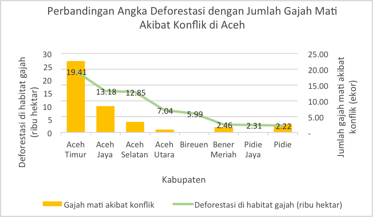Human and Elephant Conflict: The Invisible Impact of Forest Loss
Elephants play an important role in preserving the forest and the ecosystems within. As herbivors, elephants disperse seeds that will grow into new trees. In the dry season, elephants dig the ground with its tusks to find water, which can be used by all life forms. The promotion of elephants’ survival is thus vital. A subspecies of Asian elephants Elephas maximus sumatranus, for example, only lives in Sumatra.
Despite its designation as an umbrella species in Gunung Leuser National Park, the Sumatran elephant population remains unprotected today. According to the World Wildlife Fund (WWF), the population of Asian elephants has shrunk 50 percent since the 1900s. Currently, 50,000 Asian elephants are spread across thirteen countries, 2,400 of which live in Sumatra. However, according to the International Union for the Conservation of Nature (IUCN) data, 69 percent of elephant habitats in Sumatra have been lost to deforestation in the last 25 years. Considering the continuous decline of the elephant population, the preservation of elephant habitat should be top priority.
Deforestation: The Real Cause of Human and Elephant Conflict
The conflict between humans and elephants has been ongoing for a while. According to the Natural Resources Conservation Center (BKSDA) of Aceh, 55 (81 percent) out of the 68 elephant deaths that occurred throughout 2012-2017 were caused by conflict with humans. In addition to elephant deaths, the conflict also resulted in at least 11 human injuries and eight human death. The increasing number of elephant conflicts every year in Aceh resulted in the decline of elephant population from about 800 in 2003 to 500-535 by 2015. If this conflict continues, Acehnese elephants will extinct in the next 30-40 years.
Chart 1. Cases of human and elephant conflicts in Aceh in 2012-2017.
Loss of Elephant Habitat Due to Deforestation
According to the analysis of the satellite data taken from the Global Forest Watch, the Aceh Province lost 216,818 hectares (ha) of primary forest cover throughout 2001-2016. According to the data of the BKSDA of Aceh, 77,463 ha (35.7 percent) of them are vital elephant habitat.
Elephant habitats with the highest rate of deforestation are found in East Aceh and Aceh Jaya Districts, where the highest rate of fatalities from conflict were recorded in 2012-2017.

Chart 2. Comparison between deforestation in elephant habitat in 2001-2016 and the number of elephant death due to conflict in 2012-2017.
Prevention of the Loss of Elephant Habitat and Conflict with Humans
To address elephant's encroachment of human settlements, deforestation must be addressed thoroughly as the main source of the issue. The first step is the enforcement of concession licensing moratorium in high conservation value (HCV) areas. HCV areas include conservation areas, areas with high biodiversity ecological landscapes , areas with important water resources and endangered and protected animal habitats.
As a result of the conversion of conservation areas into residential, agriculture or infrastructure development areas, 85 percent of Sumatran elephant habitats are now outside a conservation area. Therefore, the government needs to expand the scope of forest moratorium outside the conservation area in order to reach all elephant habitats. The spirit to protect HCV areas should also be reflected in the preparation of the Strategic Environmental Assessment (KLHS) and the Spatial Plan (RTRW) to avoid economic losses of local communities and the decline of the elephant population due to human-wildlife conflict. The role of elephants in spreading seeds and creating pools in the dry season is vital for ecosystem balance in the forest and the livelihood of the surrounding communities.
Secondly, the government can enrich the forest by planting natural animal feed plants so that herbivores such as elephants do not need to find food outside the forest. People living around the forest can also grow plants that elephants do not like such as lemons, coffee, chili, pepper and candlenuts.
Third, the government needs to establish an effective patrol team. Patrol by foot or horses is not optimal in combing large areas of rainforest and has a difficult terrain. Forest preservation also needs the support of a technology or system that facilitates area monitoring such as drones, which can cover vast areas and challenging terrains.
Finally, combating deforestation requires accurate data, especially data that can be disseminated through an early warning system. An example of useful technology for environmental activists is the Forest Watcher application which provides data on changes in forest cover to users, even in areas without internet coverage. Forest Watcher can send deforestation data directly to a mobile device so that the patrol team can immediately inspect the location. This free application can also be used by communities living around the forest to monitor and report deforestations.
Forest loss does not only affect elephants, but also cause conflicts between humans and other wildlives, such as tigers, orangutans, sun bears and snakes. Temporary solutions such as the installation of electric fences in plantation areas will not be able to prevent human-animal conflict in the long term. Collaboration between governments, communities and non-governmental organizations is needed to prevent the loss of forest as the habitat and source of food for the fauna within.